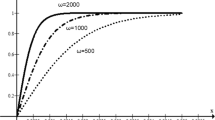Abstract
The paper presents an enhanced beam-theory (EBT) model of the mixed-mode bending (MMB) test, whereby the specimen is considered as an assemblage of two sublaminates partly connected by an elastic–brittle interface. Analytical expressions for the compliance, energy release rate, and mode mixity are deduced. A compliance calibration strategy enabling numerical or experimental evaluation of the interface elastic constants is also presented. Furthermore, analytical expressions for the crack length correction parameters—analogous to those given by the corrected beam-theory (CBT) model for unidirectional laminated specimens—are furnished for multidirectional laminated specimens, as well. Lastly, an example application to experimental data reduction is presented.












Similar content being viewed by others
References
Crews JH Jr, Reeder JR (1988) A mixed-mode bending apparatus for delamination testing. NASA TM-100662. http://ntrs.nasa.gov/archive/nasa/casi.ntrs.nasa.gov/19890001574_1989001574.pdf
Reeder JR, Crews JH Jr (1990) Mixed-mode bending method for delamination testing. AIAA J 28(7):1270–1276. doi:10.2514/3.25204
Reeder JR, Crews JH Jr (1992) Redesign of mixed-mode bending delamination test to reduce nonlinear effects. J Compos Technol Res 14(1):12–19. doi:10.1520/CTR10078J
Reeder JR (2003) Refinements to the mixed-mode bending test for delamination toughness. J Compos Technol Res 25(4):191–195. doi:10.1520/CTR10961J
ASTM (2006) Standard test method for mixed mode I-mode II interlaminar fracture toughness of unidirectional fiber reinforced polymer matrix composites, D6671/D6671M-06. Am Soc Testing Mat, West Conshohocken. doi:10.1520/D6671_D6671M-06
Adams DF, Carlsson LA, Pipes RB (2003) Experimental characterization of advanced composite materials, 3rd edn. CRC Press, Boca Raton
Bennati S, Fisicaro P, Valvo PS (2013) An enhanced beam-theory model of the mixed-mode bending (MMB) test—Part I: Literature review and mechanical model. Meccanica. doi:10.1007/s11012-012-9686-3
Kinloch AJ, Wang Y, Williams JG, Yayla P (1993) The mixed-mode delamination of fibre composite materials. Compos Sci Technol 47(3):225–237. doi:10.1016/0266-3538(93)90031-B
Williams JG (1989) End corrections for orthotropic DCB specimens. Compos Sci Technol 35(4):367–376. doi:10.1016/0266-3538(89)90058-4
Kanninen MF (1973) An augmented double cantilever beam model for studying crack propagation and arrest. Int J Fract 9(1):83–92. doi:10.1007/BF00035958
Wang Y, Williams JG (1992) Corrections for mode II fracture toughness specimens of composites materials. Compos Sci Technol 43(3):251–256. doi:10.1016/0266-3538(92)90096-L
Bhashyan S, Davidson BD (1997) Evaluation of data reduction methods for the mixed mode bending test. AIAA J 35(3):546–552. doi:10.2514/2.129
Wang JL, Qiao PZ (2004) Novel beam analysis of end notched flexure specimen for mode-II fracture. Eng Fract Mech 71(2):219–231. doi:10.1016/S0013-7944(03)00096-1
de Morais AB (2011) Novel cohesive beam model for the End-Notched Flexure (ENF) specimen. Eng Fract Mech 78(17):3017–3029. doi:10.1016/j.engfracmech.2011.08.019
Jumel J, Budzik MK, Ben Salem N, Shanahan MER (2013) Instrumented end notched flexure—crack propagation and process zone monitoring. Part I: Modelling and analysis. Int J Solids Struct 50(2):297–309. doi:10.1016/j.ijsolstr.2012.08.028
de Morais AB, Pereira AB (2006) Mixed mode I + II interlaminar fracture of glass/epoxy multidirectional laminates—Part 1: Analysis. Compos Sci Technol 66(13):1889–1895. doi:10.1016/j.compscitech.2006.04.006
Pereira AB, de Morais AB (2006) Mixed mode I + II interlaminar fracture of glass/epoxy multidirectional laminates—Part 2: Experiments. Compos Sci Technol 66(13):1896–1902. doi:10.1016/j.compscitech.2006.04.008
de Morais AB, Pereira AB (2007) Interlaminar fracture of multidirectional glass/epoxy laminates under mixed-mode I + II loading. Mech Compos Mater 43(3):233–244. doi:10.1007/s11029-007-0023-1
Pereira AB, de Morais AB (2008) Mixed mode I + II interlaminar fracture of carbon/epoxy laminates. Composites. Part A 39(2):322–333. doi:10.1016/j.compositesa.2007.10.013
Bennati S, Colleluori M, Corigliano D, Valvo PS (2009) An enhanced beam-theory model of the asymmetric double cantilever beam (ADCB) test for composite laminates. Compos Sci Technol 69(11–12):1735–1745. doi:10.1016/j.compscitech.2009.01.019
Jones RM (1999) Mechanics of composite materials, 2nd edn. Taylor & Francis, Philadelphia
Vannucci P, Verchery G (2001) A special class of uncoupled and quasi-homogeneous laminates. Compos Sci Technol 61(10):1465–1473. doi:10.1016/S0266-3538(01)00039-2
Ozdil F, Carlsson LA (1999) Beam analysis of angle-ply laminate mixed-mode bending specimens. Compos Sci Technol 59(6):937–945. doi:10.1016/S0266-3538(98)00128-6
Timoshenko SP (1984) Strength of materials: elementary theory and problems, vol 1. Krieger, Melbourne
Strand7 (2005) Theoretical manual: theoretical background to the Strand7 finite element analysis system, 1st edn. G+D Computing, Sidney
Hutchinson JW, Suo Z (1991) Mixed mode cracking in layered materials. Adv Appl Mech 29(C):63–191. doi:10.1016/S0065-2156(08)70164-9
Carlsson LA, Gillespie JW, Pipes RB (1986) On the analysis and design of the end notched flexure (ENF) specimen for mode II testing. J Compos Mater 20(6):594–604. doi:10.1177/002199838602000606
Fan C, Ben Jar P-Y, Cheng J-JR (2006) Revisit the analysis of end-notched-flexure (ENF) specimen. Compos Sci Technol 66(10):1497–1498. doi:10.1016/j.compscitech.2006.01.016
Valvo PS (2008) Does shear deformability influence the mode II delamination of laminated beams?. In: ECF17—17th European conference on fracture, 2–5 September 2008, Brno, Czech Republic
Corigliano A (1993) Formulation, identification and use of interface models in the numerical analysis of composite delamination. Int J Solids Struct 30(20):2779–2811. doi:10.1016/0020-7683(93)90154-Y
Budzik MK, Jumel J, Ben Salem N, Shanahan MER (2013) Instrumented end notched flexure—crack propagation and process zone monitoring. Part II: Data reduction and experimental. Int J Solids Struct 50(2):310–319. doi:10.1016/j.ijsolstr.2012.08.030
Ducept F, Davies P, Gamby D (1997) An experimental study to validate tests used to determine mixed mode failure criteria of glass/epoxy composites. Composites. Part A 28(8):719–729. doi:10.1016/S1359-835X(97)00012-2
Pereira AB (2006) Fractura interlaminar de compósitos de matriz polimérica. PhD thesis, University of Aveiro. http://ria.ua.pt/bitstream/10773/2549/1/2007001048.pdf
Acknowledgements
The financial support of the Italian Ministry of Education, University and Research (MIUR) under programme PRIN 2008 “Light structures based on multiscale material in civil engineering: stiffness and strength, assembly and industrial repeatability” (Prot. N. 20089RJKYN_002) is gratefully acknowledged.
Author information
Authors and Affiliations
Corresponding author
Rights and permissions
About this article
Cite this article
Bennati, S., Fisicaro, P. & Valvo, P.S. An enhanced beam-theory model of the mixed-mode bending (MMB) test—Part II: Applications and results. Meccanica 48, 465–484 (2013). https://doi.org/10.1007/s11012-012-9682-7
Received:
Accepted:
Published:
Issue Date:
DOI: https://doi.org/10.1007/s11012-012-9682-7




